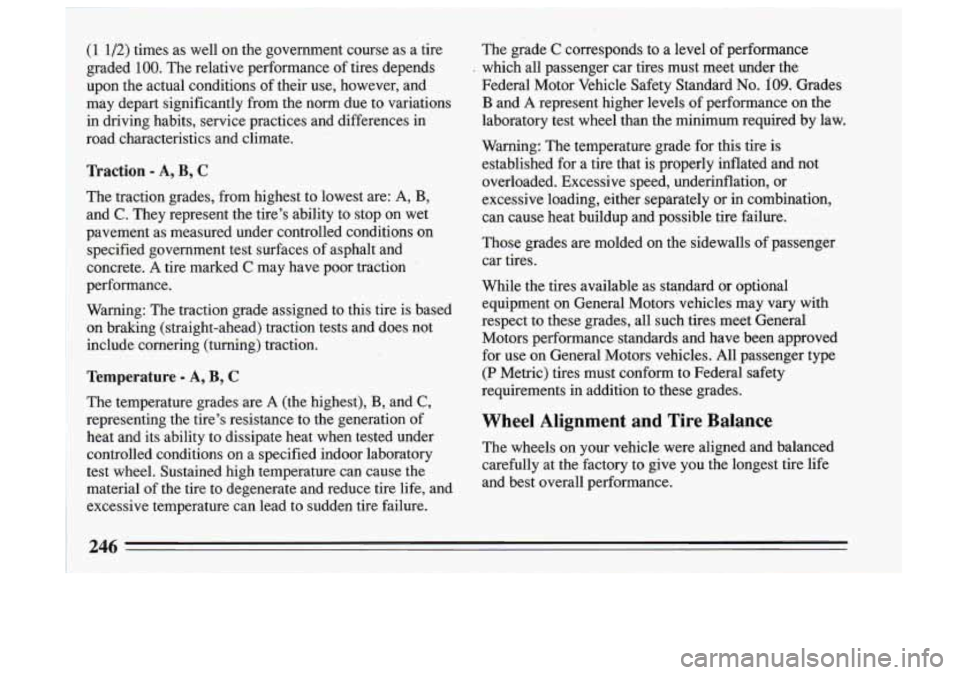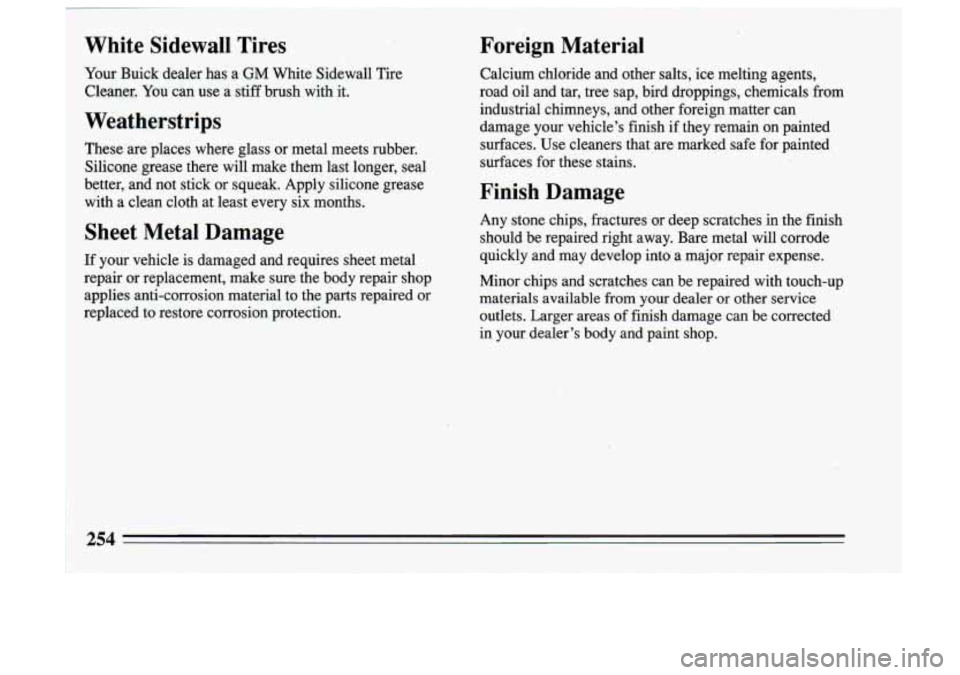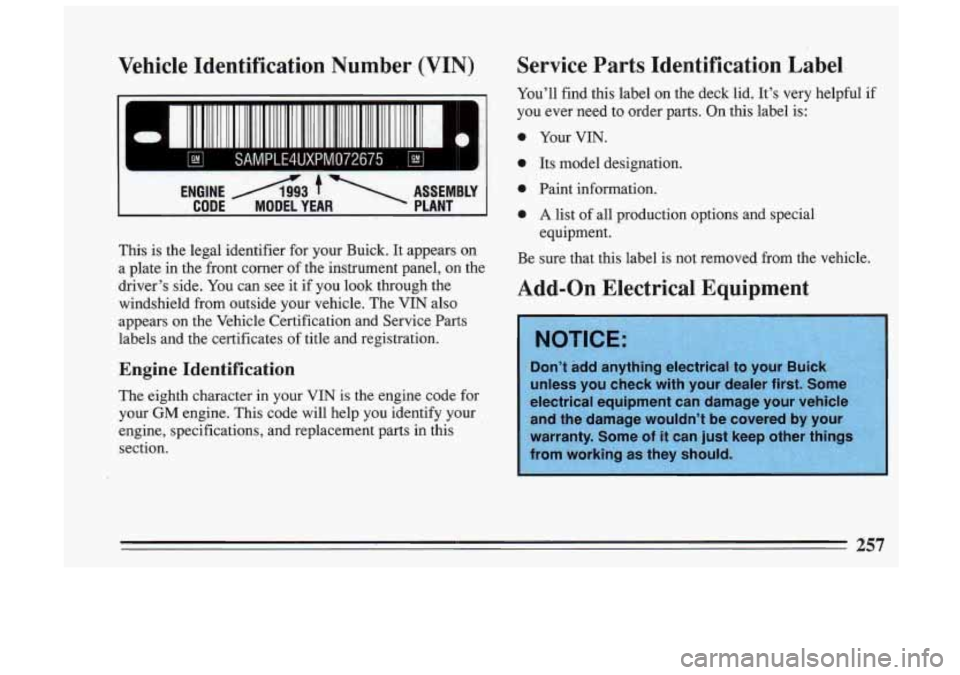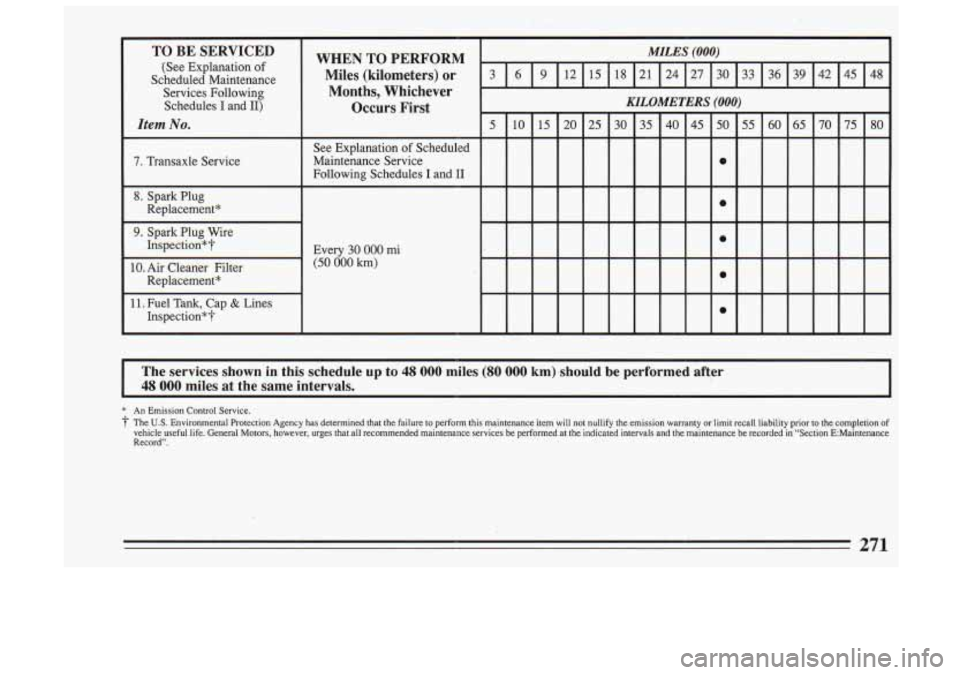1993 BUICK SKYLARK service
[x] Cancel search: servicePage 247 of 306

(1 112) times as well on the government course as a tire
graded
100. The relative performance of tires depends
upon the actual conditions of their use, however, and
may depart significantly from the norm due to variations
in driving habits, service practices.and differences in
road characteristics and climate.
’Ikaction - A, B, C
The traction grades, from highest to lowest are: A, B,
and C. They represent the tire’s.ability to stop on wet
pavement
as measured under controlled conditions on
specified government test surfaces
of asphalt and
concrete. A tire marked
C may have poor traction
performance.
Warning: The traction grade assigned to this tire is based on braking (straight-ahead) traction tests and does not
include cornering (turning) traction.
Temperature - A, B, C
The temperature grades are A (the highest), B, and C,
representing the tire’s resistance to the generation of
heat and its ability to dissipate heat when tested under controlled conditions on a- specified indoor laboratory
test wheel. Sustained high temperature can cause the
material of the tire to degenerate and reduce tire life, and
excessive temperature can lead to sudden tire failure. The
grade
C corresponds to a level of performance
Federal Motor Vehicle Safety Standard
No. 109. Grades
B and A represent higher levels of performance on the
laboratory test wheel than the minimum required by law.
Warning: The temperature grade for this tire is
established for a tire that is properly inflated and not
overloaded. Excessive speed, underinflation, or
excessive loading, either separately or in combination,
can cause heat buildup and possible tire failure.
Those grades are molded on the sidewalls of passenger
car tires.
While the tires available as standard or optional
equipment on General Motors vehicles may vary with
respect to these grades, all such tires meet General
Motors performance standards and have been approved
for use on General Motors vehicles. All passenger type
(P Metric) tires must conform to Federal safety
requirements in addition to these grades.
Wheel Alignment and Tire Balance
The wheels on your vehicle were aligned and balanced
carefully at the factory to give you the longest tire life
and best overall performance.
. which all passenger car tires must meet under the
246
Page 255 of 306

.-1
White Sidewail Tires
your Buick dealer has a GM White Sidewall Tire
Cleaner. You can use a stiff brush with it.
Weatherstrips
These are places where glass or metal meets rubber.
Silicone grease there will make them last longer, seal
better, and not stick or squeak. Apply silicone grease
with
a clean cloth at least every six months.
Sheet Metal Damage
If your vehicle is damaged and requires sheet metal
repair or replacement, make sure the body repair shop applies anti-corrosion material to the parts repaired or
replaced to restore corrosion protection.
Foreign Material
Calcium chloride and other salts, ice melting agents,
road oil and
tar, tree sap, bird droppings, chemicals from
industrial chimneys, and other foreign matter can
damage your vehicle’s finish
if they remain on painted
surfaces. Use cleaners that are marked safe for painted
surfaces for these stains.
Finish Damage
Any stone chips, fractures. or deep scratches in the finish
should be repaired right away. Bare metal will corrode
quickly and may develop into a major repair expense.
Minor chips and scratches can be repaired with touch-up materials available
from your dealer or other service
outlets. Larger areas of finish damage can be corrected
in your dealer’s body and paint shop.
254
Page 258 of 306

Vehicle Identification Number (VIN)
1111 11111 11. II I I 111 I II 11111 111 I11111 111 IIIIIIIIII II 1111 Ill II
ENGIME A3 t AQEMBLY
CODE MODEL YEAR. PLANT
This is the legal identifier for your Buick. It appears on
a plate in the front corner of the instrument panel, on the
driver’s side. You can see it if you look through the
windshield from outside your vehicle. The
VIN also
appears on the Vehicle Certification and Service Parts
labels and the certificates of title and registration.
Engine Identification
The eighth character in your VIN is the engine code for
your
GM engine. This code will help you identify your
engine, specifications, and replacement parts in this
section.
Service Parts Identification Label
You’ll find this label on the deck lid. It’s very helpful if
you ever .need to order parts. On this label is:
0 Your VIN.
0 Its model designation.
0 Paint information.
0 A list of all production options and special
Be sure that this label is not removed from the vehicle. equipment.
Add-on
Electrical Equipment
257
Page 266 of 306

Part 7 Maintenance Schedule
This part covers the maintenance required for your Buick . Your vehicle needs these services to retain its safety.
dependability and emission control performance
.
Part 7 includes:
Introduction
...................................................................... 266
A Word About Maintenance
.....................................................
Your Vehicle and the Environment ................................................ 267
How This Part is Organized
..................................................... 267
Section A: Scheduled Maintenance Services
.............................................
Using Your Maintenance Schedules ............................................... 268
Selecting the Right Schedule
....................................................
Schedule1 ................................................................... 270
Schedule11
.................................................................. 272
Explanation
of Scheduled Maintenance Services ..................................... 274
AtEachFuelFill
.............................................................. 276
At Least Once a Month .......................................................... 277
AtLeastOnceaYear
..........................................................
Section C: Periodic Maintenance Inspections ............................................ 279
Section
D: Recommended Fluids and Lubricants ......................................... 280
Section E: Maintenance Record
....................................................... 282
Section
B: Owner Checks and Services .................................................
Page 268 of 306

Your Vehicle and the Environment
Proper vehicle maintenance not only helps to keep your
vehicle in good working condition, but also helps the
environment. All recommended maintenance procedures
are important. Improper vehicle maintenance or the
removal
of important components can significantly
affect the quality of the-air we breathe. Improper fluid
levels or even the wrong tire inflation can increase the
level
of emissions from your vehicle. To help protect
our environment, and to help keep your vehicle in good
condition, please maintain your vehicle properly.
How This Part is Organized
The remainder of this part is divided into five sections:
“Section A: Scheduled Maintenance Services” shows
what to have done and how often. Some of these
services can be complex,
so unless you are technically
qualified and have the necessary equipment, you should
let your dealer’s service department or another qualified
service center do these jobs.
A CAUTION:
Performing maintenance work on a vehicle can
be dangerous. In trying to
do some jobs, you can
be seriously injured.
Do your own maintenance
work only
if you have the required know-how and
the proper tools and equipment for the job.
If you
have any doubt, have a qualified technician
do
the work.
If you are skilled enough to do some work on your
vehicle, you will probably want to get the service
information GM publishes. You will find a list of
publications and how to get. them in this manual. See
“Service Publications” in the Index.
“Section B: Owner Checks and Services” tells you what
should be checked whenever you stop for fuel. It also
explains what you can easily do to help keep your
vehicle in good condition.
“Section
C: Periodic Maintenance Inspections” explains
important inspections that your Buick dealer’s service
department or another qualified service center should
perform.
Page 269 of 306

“Section D: Recommended Fluids and Lubricants” lists Section A: Scheduled Maintenance
some products GM recommends to help keep your
vehicle properly maintained. These products,
or their Services
equivalents, should be used whether you do the work
yourself
or have it done. Using Your Maintenance Schedules
“Section E: Maintenance Record” provides a place for
you to record the maintenance performed on your
vehicle. Whenever any maintenance is performed, be
sure to write it down in this section. This will help you
determine when your next maintenance should be done.
In addition, it is a good idea to keep your maintenance
receipts. They may be needed to qualify your vehicle for warranty repairs. This section tells you the maintenance services you
should have done and when you should schedule them.
Your Buick dealer knows your vehicle best and wants
you
to be happy with it. If you go to your dealer for your
service needs, you’ll know that GM-trained and
supported service people will perform the work using
genuine GM parts.
These schedules are for vehicles that:
0
0
0 carry passengers and cargo within recommended
limits. You will find these limits on your vehicle’s
Tire-Loading Information label. See “Loading Your Vehicle” in the Index.
are driven on reasonable road surfaces within legal
driving limits.
use the recommended unleaded fuel. See “Fuel”
in
the Index.
268
Page 271 of 306

I
b Scheduled Maintenance Services Schedule I -
Follow Schedule I if your car is MAINLY driven under one or more of the following conditions:
0 When most trips are less than 4 miles (6 kilometers).
0 When most trips are less. than 10 miles (16 kilometers) and outside temperatures remain below freezing.
0 When most trips indude extended idling and/or frequent low-speed operation as in stop-a\
nd-go traffic.
0 Towing a trailer."?
0 When operating in dusty areas.
Schedule I should also be followed if the car is used for delivery service, police, taxi or other commercial app\
lications.
TO BE SERVICED
(See Explanation of
Scheduled Maintenance Miles (kilometers) or
Services Following Months, Whichever
WHEN
TO PERFORM
Schedules I and 10
Item No. I
Occurs First
1. hgine
Oil & Filter Change months I
Every 3000 mi. (5000 km) or
2. Chassis Lubrication I Every other oil change
3. Throttle Body Mounting At 6 000 mi. (10 000 km)
Bolt Torque*
At
6 000'mi. (10 000 km) and
km) or as necessary
4. Tire & Inspection & then every 15 000 mi. (25 000
Rotation
5. Engine Accessory Drive
Belt(s) Inspection* Every
30 000 mi. (50 000 km) or 24 months.
MILES (000)
3 16 19 112115118121124127130(33136139142145148
5 10
a.
..
0
0
KILOMETERS (000)
65 70 75 80
a...
0 a
270
Page 272 of 306

TO BE SERVICED
[See Explanation of
Scheduled Maintenance Miles (kilometers) or
WHEN
TO PERFORM
Services Following: I Months, Whichever
Schedules I and 16
Item No. I
Occurs First
7. Transaxle
Service See Explanation
of Scheduled
Maintenance Service
Following Schedules
I and I1
8. Spark Plug
Replacement*
9. Spark Plug Wire Inspection*T
10.
Air Cleaner Filter
Replacement*
Inspection*?
11. Fuel Tank, Cap & Lines Every
30 000 mi
(50 000 km)
MZLES (000) I ..
36912
KILOMETERS (000) . ’ I
The services
shown in this schedule up to 48 000 miles (80 000 km) should be performed after
48 000 miles at the same intervals.
* An Emission Control Service.
T The U.S. Environmental Protection Agency has determined that the failure to perform this maintenance item will not nullify the emission warranty or limit recall liability prior to the completion of
Record”. vehicle useful
life. General Motors, however, urges that all recommended maintenance services be performed at the indicated intervals and the maintenance be recorded in “Section E:Maintenance